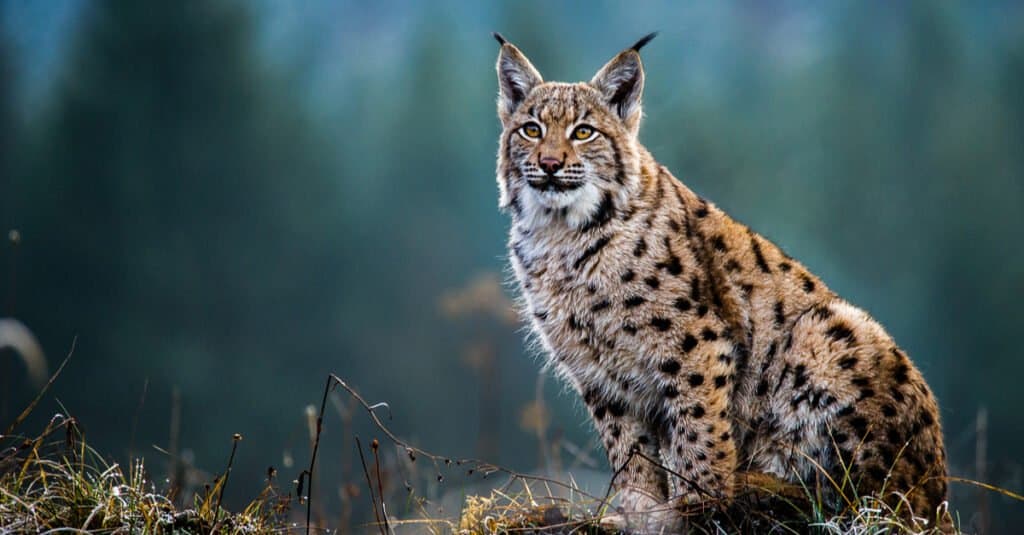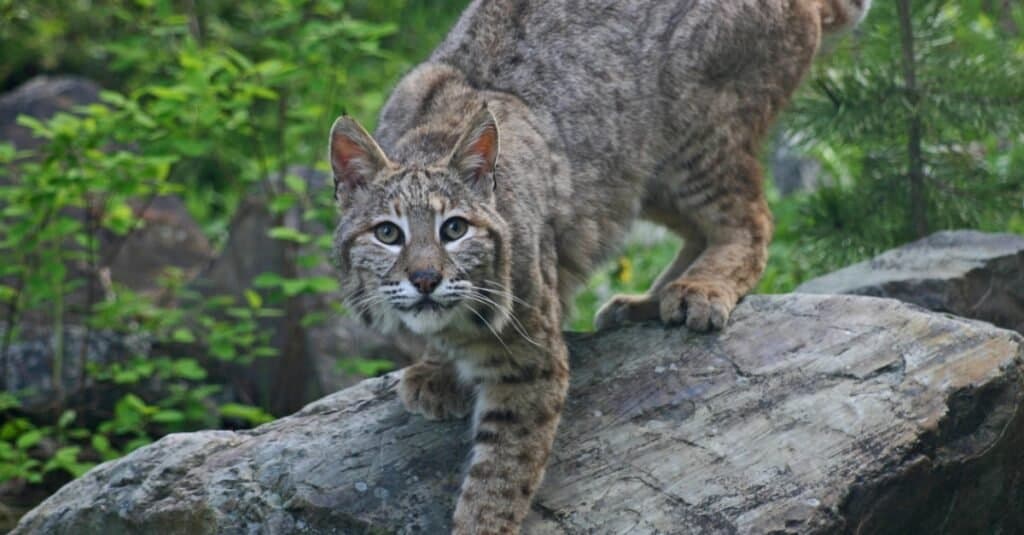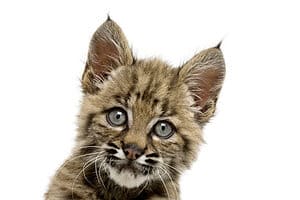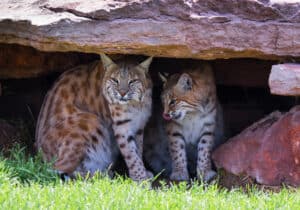Key Points:
- The term “lynx” is a genus encompassing four types of lynx. Bobcats, also known as the red lynx, are part of the lynx genus.
- Lynxes differ from the red lynx (bobcat) in several ways, including size, legs and feet, and fur color and patterns.
- The geographical range is a key difference between the bobcat and lynx, as the bobcat is the only member of the lynx genus found in the United States and Mexico.
Expert climbers, deadly predators, and dotting parents: the bobcat is an iconic piece of American wildlife. Sporting unique ear tufts and long cheek hairs, these medium-sized wild cats are easy enough to identify in the wild, especially compared to mountain lions and ocelots.
What many people may be confused about, though, is the difference between a lynx and a bobcat. The answer to that question is both simple but also complex. From a taxonomical perspective, the lynx is a genus of wild cats that includes four species: the Canadian lynx, the Iberian lynx, the Eurasian lynx, and the bobcat.
That’s right: the bobcat is really just a type of lynx (it even goes by the alternative name of red lynx). This is a good case where old, folk names don’t exactly map perfectly onto scientific reality.
On the other hand, the bobcat and Canadian lynx are more similar to each other, both genetically and evolutionary-wise, than either one is to the Eurasian or Iberian lynx.
And yet it’s still possible to point out a few features unique to the bobcat, which the other members of the lynx genus may not share. These differences are interesting in what it says about the bobcat’s lifestyle. For the purpose of this article, the term bobcat will refer to a single species, Lynx rufus, also known as just the bobcat or the red lynx.
The term lynx will apply to the other three species of the genus: the Eurasian, Iberian, and Canadian lynxes. Read on to discover the differences between lynx vs bobcat.
Bobcat vs. Lynx: Where Do They Live?
Bobcats exclusively exist in North America, whereas lynx live in Europe, Russia, Asia, and North America. In North America, the Canada lynx and bobcats are the two species of lynx that can be found. The Canada lynx is mostly found in the boreal woods of Canada and Alaska, while the bobcat is widespread over southern Canada, the United States, and northern Mexico.
Comparing Bobcat (Red Lynx) and Lynx

The lynx is a reclusive and solitary hunter.
©Tomas Hulik ARTpoint/Shutterstock.com
The lynx is a medium-sized wild cat with long legs, a short tail, and tufts of black hair on the tips of the ears. The purpose of these tufts isn’t clear yet, but they may serve as a sensing device of some sort. These are reclusive and solitary hunters; they would rather run away from people than fight. While the bobcat (or red lynx) shares many of these same features, there are a few subtle differences that help to distinguish the lynx vs bobcat. Here’s a quick breakdown of these differences.
| Category | Bobcat (Red Lynx) | Lynx |
|---|---|---|
| Length | 26 to 41 in (65 to 105 cm) | 31 to 51 in (79 to 130 cm) |
| Weight | 11 to 37 lbs (5 to 17 kg) | 18 to 64 lbs (8 to 29 kg) |
| Habitat | Temperate woodlands, swamps, deserts, and mountains | Steppes, forests, and mountains |
| Geographical Range | United States, Mexico, and Southern Canada | Canada, Spain, and the rest of Europe and Asia |
| Body | Smaller body with bare soles on the feet | Large body with padded feet |
The 4 Key Differences between Bobcats and Lynxes
Range
The geographical range is always the most obvious giveaway of whether it’s a bobcat or a lynx. Except for a few overlapping places, the bobcat is the only member of the lynx genus found in the United States and Mexico. Whereas the Canadian, Eurasian, and (to a lesser extent) Iberian lynx are mostly found in cold environments that receive a lot of annual snowfall, the bobcat inhabits a wide range of different ecosystems, including deserts and swamps.
Bobcats are therefore quite easy to identify from their habitat alone. The only regions where they overlap with the range of the Canadian lynx are southern Canada and a few states like Washington and Montana. In these areas, you would need to be a little more discerning to correctly identify the animal.

The bobcat is the only member of the lynx genus found in the
United States
and
Mexico
.
©iStock.com/twildlife
Size
The bobcat is the smallest of the four lynx species. It reaches a maximum length of 41 inches from head to tail and a maximum height of about 2 feet. It’s also the smallest in terms of weight. The Canadian lynx is only slightly larger, however, so it might be difficult to distinguish them at a glance from size alone, especially given the fact that individuals vary so much in size.
Bobcats have smaller feet than other lynxes. Also, the bottoms of their paws are not covered in fur like those of the others in their species. This is most likely due to the fact that they don’t need extra traction for snowy regions.
Legs and Feet
Most members of the lynx genus are well-adapted for life in harsh, cold climates. Their big padded soles, long legs, and splayed toes enable them to walk nimbly on the snow. The bobcat is a bit of an exception. Its natural range extends all the way to the southern United States and Mexico, which received barely any snow at all. The bottoms of their paws are likewise relatively bereft of fur, and they have shorter legs.
Fur Color and Patterns
It’s difficult to make too many generalizations about the lynx’s fur color because it tends to vary quite a bit between gray, yellow, tan, and brown, depending on the season. But the bobcat usually features a brown coat of fur with darker black spots and a black-banded tail.
It generally has more spots than the Canadian lynx but perhaps fewer than the Iberian lynx. This fur pattern serves the function of allowing the bobcat to blend in with its surrounding environment and strike its prey quickly. It also has shorter tufts of fur springing from the cheeks and ears compared to the closely related Canadian lynx.
Summary: Bobcat (Red Lynx) vs. Lynx
To put it simply: bobcats are a species of lynx. Comparatively, bobcats do differ from other lynx species, and here’s a recap of the key differences.
| Number | Category | Difference |
|---|---|---|
| 1 | Range | Bobcats exist only in North America, whereas lynx live in Europe, Russia, Asia, and North America. |
| 2 | Size | The bobcat is the smallest in height and weight of the four lynx species. |
| 3 | Legs and Feet | Bobcats have smaller feet than other lynxes. |
| 4 | Fur Color and Patterns | The lynx’s fur color varies depending on the season. The bobcat typically has a brown coat of fur with more spots than the Canadian lynx but perhaps fewer than the Iberian lynx. |
Bonus: Do Bobcats Prey on Pets?

Bobcats will eat anything they can bring down – including small pets.
©iStock.com/Anita Elder Design
After comparing the bobcat to the lynx you may wonder if these fierce felines will prey on your small pets. In the case of the bobcat – the answer is yes, if the opportunity presents itself. While attacks on pets aren’t common they are increasing in frequency as humans continue to encroach on their native habitats. Bobcats are highly adaptive – which is a major reason for their success as a species. If people move into their territory – they will adapt – perhaps finding small dogs and domestic cats to be easy new prey.
Small dogs left in fenced backyards are easy game for these agile predators. They can jump or climb a fence with minimal effort and are powerful animals. Pet cats that roam outside would also be easy targets for experienced hunters. Farm animals like goats and chickens are also at risk. If you suspect a bobcat is in your neighborhood, keep your cats inside and don’t leave small dogs outside alone. Goats and chickens can be protected by trained guard dogs.
The photo featured at the top of this post is ©
FAQs (Frequently Asked Questions)
Which is more dangerous, the lynx or the bobcat?
Both animals are about equally aggressive, but on account of their larger weight, the lynx is probably a little stronger than the bobcat and might prevail in a fight between them. Either way, humans have nothing to fear from these cats. They will always attempt to run away when they encounter people and would not attempt to fight unless directly threatened.
Which cat is bigger, the bobcat or the lynx?
Of all the members of the genus, the Eurasian lynx is the largest on average, followed by the Iberian lynx, and then the Canadian lynx. This leaves the bobcat as the smallest. However, this doesn’t account for natural variability between individuals. Larger bobcats might eclipse smaller lynxes in size.
Can a bobcat and lynx mate?
The bobcat and Canadian lynx have been known to create hybridized offspring called a blynx or a lynxcat. This hybrid has a bobcat-like face and may or may not have distinctive spots. Whereas many hybrids are sterile, the blynx has been known to produce viable offspring on their own.
How do you identify a bobcat vs. a lynx?
You can identify a bobcat by its smaller size, its relatively bare feet, and the shorter fur on its head. It’s also the only one found in most of the United States and Mexico.
Thank you for reading! Have some feedback for us? Contact the AZ Animals editorial team.






